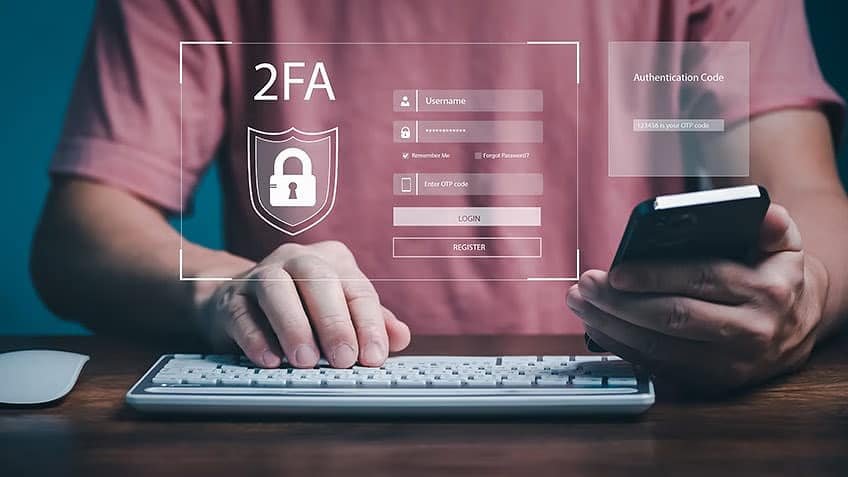Two-Factor Authentication (2FA) for Banking Explained: Why You Absolutely Need It
Remember that sinking feeling you get when an email pops up from your bank saying, “A suspicious login attempt was detected”? That moment of panic is a harsh reminder that a simple password isn’t enough to protect your money. In a world of increasing data breaches and sophisticated phishing scams, relying on a single layer of security is like leaving your front door unlocked in a busy city.
This is where Two-Factor Authentication (2FA) comes in. It’s the single most effective step you can take to secure your financial accounts. As a Computer Science graduate with a decade of experience in the technology sector, I’ve seen firsthand how a small, proactive step like enabling 2FA can stop a hacker dead in their tracks. I want to break down exactly what 2FA is, how it works, and show you why it’s an essential, non-negotiable layer of security for your bank account.
What is Two-Factor Authentication (2FA)? A Simple Explanation
At its core, Two-Factor Authentication (2FA) is an account security method that requires two different types of proof of identity before you’re granted access. Think of it as a second key for a second lock on your digital vault. It’s based on the three fundamental factors of authentication:
- Something You Know: This is information that only you should know, such as your password, a PIN, or the answer to a security question. This is the most common factor and the one most vulnerable to attack.
- Something You Have: This is a physical object in your possession, such as your mobile phone, a smart card, a physical security key, or a bank card. The system trusts that because you have this item, you are who you say you are.
- Something You Are: This is a part of your unique biological identity, such as your fingerprint, your face, or your voice (also known as biometrics). Modern smartphones and laptops have built-in biometric scanners that make this a convenient and secure option.
The “2FA Formula” combines any two of these factors. For example, you use your password (something you know) plus a code sent to your phone (something you have) to log in. This combination makes it exponentially harder for a scammer to gain unauthorized access because they would need to steal both your password and your physical device.
How is 2FA Different from MFA?
You’ll often hear the terms 2FA and MFA used interchangeably, but there’s a subtle and important distinction. 2FA is a specific type of Multi-Factor Authentication (MFA).
- 2FA uses exactly two authentication factors.
- MFA uses two or more authentication factors.
Therefore, every 2FA system is a type of MFA, but an MFA system might use three factors (e.g., a password, a fingerprint, and a physical security key). For most everyday users, the two terms are functionally the same, but it’s important to understand that MFA is the broader category.
Now that we’ve broken down the fundamental principles of 2FA, let’s explore why this simple step is an absolute must-have for protecting your money.
Why is 2FA Essential for Banking and Online Payments?
In my experience, the single biggest misconception about online security is that a strong password is enough. It’s not. Data breaches are a daily occurrence, and your password, no matter how complex, may already be for sale on the dark web. The primary advantage of 2FA in online banking is that it renders a stolen password useless. Even if a cybercriminal obtains your credentials from a phishing scam or a data breach, they still cannot get into your account because they don’t have the second factor.
In the context of banking and online payments, 2FA serves several vital purposes:
- It protects your money by stopping unauthorized transfers and transactions. It prevents credential stuffing attacks, where hackers take a list of stolen usernames and passwords from one site and try them on thousands of other sites.
- It secures your personal data—your address, account numbers, and transaction history—from thieves who could use that information for further identity fraud.
- It helps you comply with the robust security policies that modern banks have put in place to protect their customers and adhere to financial regulations.
The “Cost” of Not Using 2FA
Ignoring 2FA comes with a significant and tangible cost. While it may seem like a minor inconvenience, the time and financial losses from a compromised account are far worse. Without 2FA, you are at risk of:
- Financial Loss: A hacker can drain your savings, make fraudulent purchases, or initiate unauthorized wire transfers.
- Identity Theft: Once a scammer has access to your bank account, they often have access to a treasure trove of personal information that can be used to open new accounts or commit other forms of fraud in your name.
- Time and Stress: The process of recovering from a compromised account is lengthy and frustrating. It involves contacting your bank, filing reports, and constantly monitoring your credit and other accounts for further suspicious activity.
Understanding the stakes makes the “why” clear. Next, let’s get into the practical details and explore the different types of 2FA you’ll encounter and their unique strengths and weaknesses.
How 2FA Works: The Most Common Examples Explained
While the concept of 2FA is straightforward, the methods used to implement it can vary. Here are the most common examples, from the least secure to the most secure.
SMS & Email Codes (The Baseline)
This is the most common and oldest form of 2FA you’ll encounter. After entering your password, your bank texts or emails you a one-time code to confirm your identity.
- Pros: It’s ubiquitous, easy to use, and requires no special apps.
- Cons: This method is vulnerable to a sophisticated attack called SIM swapping. A criminal can trick your mobile carrier into porting your phone number to their own device. When they do this, they can intercept all of your calls and text messages, including the one-time verification codes, allowing them to bypass this security layer. For this reason, it’s considered the least secure 2FA method.
Authenticator Apps (The Best Practice)
Authenticator apps generate a Time-based One-Time Password (TOTP) on your device. The app and the bank’s server both use a shared secret key and the current time to generate the same six-digit code, which is valid for only 30 to 60 seconds. You don’t need a cellular signal or an internet connection for the code to generate, making it a very reliable method.
You’ve likely seen this in action with popular apps like Google Authenticator, Microsoft Authenticator, or Authy.
- Pros: They are highly secure and not vulnerable to SIM swapping because the codes are generated directly on your device.
- Cons: If you lose your phone and haven’t saved your backup codes, you could be locked out of your account.
Physical Security Keys (The Gold Standard)
A physical security key, such as a YubiKey, is a small USB or Bluetooth device that acts as your second factor. These keys are built on industry standards created by organizations like the FIDO Alliance. To log in, you simply plug in the key or tap it to a compatible device to confirm your identity.
- Pros: This is the highest level of personal security. Physical keys are virtually phishing-proof because they verify the actual website’s domain before providing the authentication token, ensuring you can’t be tricked into giving up your credentials to a fake site.
Push Notifications & Biometrics
Many services also offer push notifications or biometrics as a second factor. Push notifications are login approval requests that appear on your phone, requiring a simple tap to approve or deny. Biometrics, like Face ID or a fingerprint scan, use your device’s hardware to verify your identity. These are often used in combination with an authenticator app for a seamless, user-friendly experience.
A Quick Comparison of 2FA Methods
| Method | Security Level | Key Advantage | Main Weakness |
|---|---|---|---|
| SMS / Email | Good (Baseline) | Easy to use | Vulnerable to SIM Swapping |
| Authenticator App | Excellent | Highly secure, Works Offline | Requires saving backup codes |
| Physical Key | Exceptional | Phishing-Proof | Requires a physical device |
While no security measure is perfect, 2FA dramatically raises the bar for cybercriminals. But can even this powerful tool be beaten? Let’s take a look at the rare cases where 2FA can be bypassed.
The Big Question: Can Your Account Still Be Hacked with 2FA?
This is an excellent question that demonstrates a crucial understanding of cybersecurity: no security measure is a 100% impenetrable fortress. The honest answer is yes, a determined and skilled hacker might still be able to gain access, but it is significantly harder and requires far more effort.
The most common ways to bypass even a 2FA-protected account are through:
- Advanced Phishing (Man-in-the-Middle Attacks): This type of attack is designed to get your password and your 2FA code in real time. A scammer creates a fake login page that looks identical to your bank’s. When you enter your password and then your 2FA code, the fake site immediately relays them to the real bank’s site, logging the hacker in and hijacking your session before the 2FA code expires.
- SIM Swapping: As mentioned earlier, this is a direct attack on SMS-based 2FA. The scammer’s goal is to convince your mobile provider to transfer your phone number to a new SIM card they control.
- Session Hijacking: This attack involves stealing an active login session. A hacker can steal the cookie that your browser uses to stay logged in to a website. By using this cookie, the hacker can bypass the entire login process, including the 2FA step, because they are effectively continuing a session that you already initiated.
The bottom line is that 2FA stops the vast majority of automated, low-effort attacks that rely on a simple stolen password. It’s a powerful deterrent that protects you from the most common cyber threats.
While these attacks highlight the need for continued vigilance, they are far less common than attacks on non-2FA accounts. The most important step is setting it up. Let’s walk through the process together.
How to Set Up 2FA on Your Bank Account: A Step-by-Step Guide
Enabling 2FA is a straightforward process that takes less than five minutes.
Step 1: Log In to Your Online Banking Portal. Use a secure computer and a trusted network. Never use public Wi-Fi or a shared computer to access your financial accounts.
Step 2: Navigate to the “Security” Settings. Once logged in, look for a section titled “Security,” “Login & Security,” “2-Step Verification,” or “Two-Factor Authentication.” This is often found within your profile or account settings.
Step 3: Choose Your 2FA Method. Your bank will likely offer SMS, an authenticator app, or both. Strongly recommend choosing an authenticator app over SMS for the highest level of security. If your bank only offers SMS, enable it anyway as a crucial first step.
Step 4: Follow the On-Screen Instructions. If you choose the authenticator app, the bank will display a QR code. Open your authenticator app on your phone, tap the “+” button, and scan the QR code to link your account. The app will immediately start generating codes.
Step 5: CRITICAL STEP – Save Your Backup Codes. After you set up 2FA, your bank will provide a list of one-time backup codes. These are essential if you lose, break, or replace your phone. You can use one of these codes to regain access to your account. It is imperative that you save these codes somewhere safe and offline. Print them out and store them in a home safe, a locked desk drawer, or a physical document folder. Do not take a screenshot or store them in a notes app on your phone.
With 2FA now enabled, you’ve added a powerful layer of defense to your accounts. Let’s answer a few more common questions to ensure you’re fully prepared to navigate the digital world safely.
Frequently Asked Questions (FAQ)
Q: What’s the difference between 2FA and Multi-Factor Authentication (MFA)?
A: 2FA uses exactly two authentication factors. MFA is a broader term that means using two or more factors. All 2FA is a type of MFA, but not all MFA is 2FA (e.g., using a password, a physical key, and a fingerprint).
Q: What is the best practice for two-factor authentication?
A: The most effective practice is to use an authenticator app (like Google Authenticator or Authy) or a physical security key (like a YubiKey). These methods are not vulnerable to SIM swapping, which is a major weakness of SMS-based 2FA. This recommendation is echoed by government cybersecurity agencies like CISA.
Q: What about 2FA for Google, Facebook, or Instagram?
A: The same principles apply! The same types of phishing and account hijacking threats exist on social media and email platforms. You can find 2FA options in the security settings of all major online accounts and should enable it on all of them to protect your digital identity, not just your financial ones.
Q: What happens if I lose my phone or forget my password?
A: This is why backup codes are critical. If you’ve saved them, you can enter one of those codes to access your account. If not, you will need to contact your bank’s support team to go through a manual, and often lengthy, account recovery process to verify your identity.
Q: What is the best way to manage 2FA for multiple bank accounts?
A: The most convenient and secure way is to use a single, reputable authenticator app (like Authy, which allows for cloud backup) to manage all your bank and other online accounts in one place. This centralizes all your codes and simplifies the process.
Q: Are biometrics (Face ID, fingerprint) considered a form of 2FA?
A: Yes, they are. Biometrics fall under the “Something You Are” authentication factor. When you use your fingerprint or face to log in after entering a password, you are effectively using a form of 2FA.
Q: Can I get phished even if I use 2FA?
A: Yes. While 2FA makes it significantly harder, sophisticated scams exist. Hackers can create a fake website that not only steals your password but also prompts you for your real-time 2FA code, which they immediately use to log in to your actual account. The best defense is vigilance: always check the URL of any website you are logging into.
Q: Why don’t banks just force everyone to use 2FA?
A: While many banks are moving towards mandatory 2FA, some still offer it as an option due to a balance between security and user experience. Forcing a security measure can cause user frustration and support issues, especially for those who are less tech-savvy. However, regulatory bodies are increasingly making MFA a requirement for financial institutions.
Q: How can I tell if my bank’s 2FA is secure?
A: The most secure 2FA methods are those that are not vulnerable to SIM swapping or phishing. The best way to tell is to check if your bank offers an authenticator app or a physical security key. If a bank only offers SMS, it’s a good sign that they have not implemented the most up-to-date security measures. While still better than nothing, it’s worth knowing the difference.
Q: What if my phone doesn’t have a cellular signal?
A: This is one of the key advantages of authenticator apps and physical security keys. These methods do not rely on a cellular signal or internet connection to generate codes, so they will work even if you are in a location with no reception. This makes them a more reliable form of authentication for travel or areas with poor service.
Q: What is the difference between an authenticator app and a password manager?
A: A password manager (like LastPass or 1Password) securely stores and generates complex passwords, solving the “Something You Know” problem. An authenticator app (like Google Authenticator or Authy) generates the time-based codes for the “Something You Have” factor. Both are essential and complementary tools for modern cybersecurity.
Conclusion
A password is a lock on your digital front door. In today’s threat landscape, two-factor authentication is the deadbolt. In 2025, you absolutely need both for your financial accounts.
Enabling 2FA is the single most powerful action you can take in less than five minutes to protect your money and data. If you haven’t already, stop what you’re doing right now, log in to your bank’s website, and enable two-factor authentication. You’ll thank yourself later.
Oladepo Babatunde is the founder of TechFinanceGuide.com and a seasoned technology professional specializing in the dynamic intersection of technology and finance. As a Computer Science graduate (HND) with over a decade of hands-on experience in the tech sector since 2011, he combines deep technical knowledge with a passion for financial innovation.
Oladepo’s mission at TechFinanceGuide is to bridge the gap between powerful financial technology and the everyday user. He is committed to delivering well-researched, actionable content that empowers readers to make informed financial decisions, navigate digital payment systems safely, and understand the trends shaping our future. From blockchain and investment tools to cybersecurity and mobile banking, his articles provide clear guidance in an ever-evolving landscape.
Beyond writing, Oladepo remains a dedicated analyst of the tech landscape, constantly evaluating the breakthroughs that reshape global finance. Connect with him on LinkedIn for in-depth discussions and insights on leveraging technology in the world of finance.






